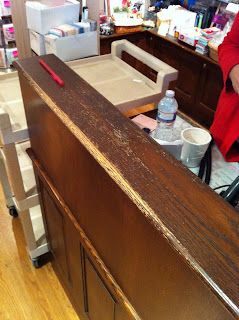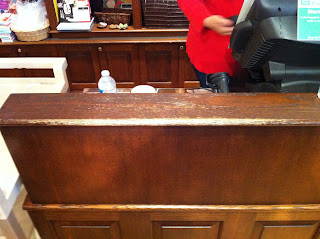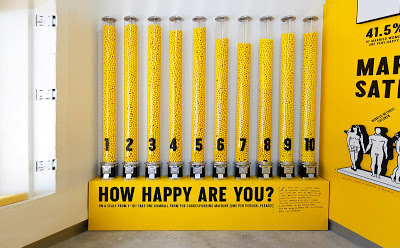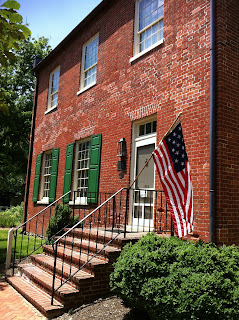This is the checkout counter of the gift shop at the Mansion at Strathmore part of the Strathmore Arts Center in Bethesda, Maryland. The gift shop has seen many patrons. Standing to pay for purchases they rub against the edge of the counter. This results in a region of more centrally located wear with less wear extending to the right and left. Yet another, common, bell-shaped distribution pattern of wear. Here's another view.
Monday, July 29, 2013
Monday, July 22, 2013
Things Shouldn't Be So Hard
Here is "a worn-out place" where restaurant servers stand to collect plates and silverware to set up the tables for new patrons. Many feet have stepped, dirtied, or worn away these kitchen floor tiles. More wear at a central target and less wear towards the edges. This is a frequency patten that we have seen often.
It brings to mind the poem "Things Shouldn't Be So Hard," by former US Poet Laureate and MacArthur Fellow, Kay Ryan (via the NYTimes). Considering all the worn and marked things we have illustrated in these postings, Ryan's poem could be the defining wish for this blog.
THINGS SHOULDN'T BE SO HARD
It brings to mind the poem "Things Shouldn't Be So Hard," by former US Poet Laureate and MacArthur Fellow, Kay Ryan (via the NYTimes). Considering all the worn and marked things we have illustrated in these postings, Ryan's poem could be the defining wish for this blog.
THINGS SHOULDN'T BE SO HARD
A life should leave
deep tracks:
ruts where she
went out and back
to get the mail
or move the hose
around the yard;
where she used to
stand before the sink,
a worn-out place;
beneath her hand
the china knobs
rubbed down to
white pastilles;
the switch she
used to feel for
in the dark
almost erased.
Her things should
keep her marks.
The passage
of a life should show;
it should abrade.
And when life stops,
a certain space—
however small —
should be left scarred
by the grand and
damaging parade.
Things shouldn't
be so hard.
deep tracks:
ruts where she
went out and back
to get the mail
or move the hose
around the yard;
where she used to
stand before the sink,
a worn-out place;
beneath her hand
the china knobs
rubbed down to
white pastilles;
the switch she
used to feel for
in the dark
almost erased.
Her things should
keep her marks.
The passage
of a life should show;
it should abrade.
And when life stops,
a certain space—
however small —
should be left scarred
by the grand and
damaging parade.
Things shouldn't
be so hard.
Monday, July 15, 2013
Home Advice Lacks Skewness
I recently saw this TV commercial for Home Advisor a website that helps homeowners find home improvement professionals. The homeowners then report their costs for the repairs. The site displays a symmetric bell-shaped curve to show the distribution of these costs, irrespective of the shape of their actual distribution. The image above shows that the average cost for cleaning gutters is $180 and that "most homeowners" spent between $158 and $202. These values appear to mark the locations of the inflection points for the curve. If we assume the curve describes a normal distribution of costs, these points lie at one standard deviation above and below the mean. Indicating that the standard deviation is $22. For a normal distribution, about 68% ( the website's "most homeowners") spent within $22 of the mean of $180. The minimum cost of $90 is about 4.1 standard deviations below the mean. Its placement on the graph seems appropriate. But the maximum cost of $300 is about 5.5 standard deviations above the mean. Maximum costs for other services sometimes exceed 5 and even 6 standard deviations above the mean, but are placed symmetrically with costs at about 4 standard deviations below the mean. The symmetric graphic hides the right skewness that we should expect in almost any monetary variable that is only bounded below by zero.
It would be better to show the actual histogram of costs perhaps with a superimposed curve like we have seen previously with GetMarketPrice or TRUEcar.
It would be better to show the actual histogram of costs perhaps with a superimposed curve like we have seen previously with GetMarketPrice or TRUEcar.
Labels:
bell-curve,
bell-shaped,
distribution,
skew,
standard deviation
Monday, July 8, 2013
Happiness in Negative Space
This image is from an Institute of Contemporary Art, Philadelphia exhibit called The Happy Show by Stefan Sagmeister that just ended its tour at the Institute of Museum of Contemporary Art, Los Angeles Pacific Design Center. In this display, included in the exhibit, people were instructed to select one gumball from column that indicated their level of happiness (1 to 10). The bar chart of the happiness level of those that participated is shown in the negative space above each column, showing how many gumballs were removed. Median happiness here looks to be about a 7. We've seen a similar exhibit before.
Monday, July 1, 2013
Beall Shaped
The Beall-Dawson House in Rockville, Maryland is an 1815 Federal-style home built for Upton Beall, then Clerk of the Circuit Court. It has been owned since 1960 by the Montgomery County Historical Society. Almost 200 years of use has left its mark. Below is the wooden threshold leading into the home's main parlor. The threshold shows the pattern we have seen often, the most wear in the middle where the frequency of use is greatest, trailing off to lesser usage and wear at the edges. A bell- (Beall?)-shaped distribution of wear.
Labels:
bell-curve,
bell-shaped,
distribution,
frequency
Subscribe to:
Posts (Atom)







